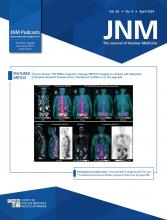Abstract
Molecular imaging techniques like positron emission tomography (PET) and single-photon emission computed tomography (SPECT) have been used to shed light on how the Corona Virus Disease 2019 (COVID-19) affects the human brain. We provide a systematic review that summarizes the current literature according to five predominant topics: 1. Few case reports suggest reversible cortical and subcortical metabolic alterations in rare cases with concomitant, para- or post-infectious encephalitis. 2. Imaging findings in single patients with first manifestations of parkinsonism in the context of COVID-19 resemble those in neurodegenerative parkinsonism (loss of nigrostriatal integrity), but scarceness of data and a lack of follow-up preclude further etiological conclusions (e.g., unmasking/hastening of neurodegeneration vs. (para-) infectious parkinsonism). 3. Several case reports and few systematic studies addressed focal symptoms and lesions, most notably hyposmia. Results are variable, although some studies found regional hypometabolism of regions related to olfaction (e.g., orbitofrontal and mesiotemporal). 4. A case series and systematic studies in inpatients with COVID-19-related encephalopathy (acute to subacute stage) consistently found a frontoparietal-dominant neocortical dysfunction (on imaging and clinically) that proved to be grossly reversible in the majority of cases until 6 months. 5. Studies in “Post-COVID-19 syndrome” provided controversial results. In patients with a high level of self-reported complaints (e.g., fatigue, memory impairment, hyposmia, dyspnea) some authors found extensive areas of limbic and subcortical hypometabolism, while others found no metabolic alterations on PET and only minor cognitive impairments (if any) on neuropsychological assessment. Furthermore, we provide a critical appraisal of studies in regard of frequent methodological issues and current pathophysiological concepts. Finally, we devised possible applications of PET and SPECT in the clinical work-up of diagnostic questions related to COVID-19.
Footnotes
Immediate Open Access: Creative Commons Attribution 4.0 International License (CC BY) allows users to share and adapt with attribution, excluding materials credited to previous publications. License: https://creativecommons.org/licenses/by/4.0/. Details: https://jnm.snmjournals.org/page/permissions.
- Copyright © 2022 by the Society of Nuclear Medicine and Molecular Imaging, Inc.







